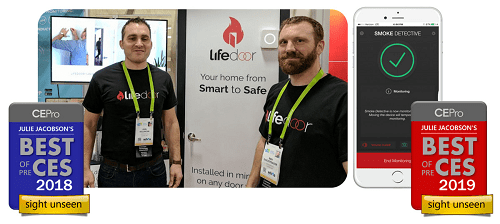
12.14.18 – CEPro – Julie Jacobson ·
Smoke Detective turns any smart phone or camera-enabled device into a smoke detector … and other innovations in smoke, CO and fire safety at CES 2019.
Smoke, fire and CO detectors might not be the sexiest smart things at CES 2019, but the newest crop of detection, prevention and loss-mitigation products could save a life or two.
No need to rehash the statistics on smoke, fire and CO damages every year. They’re bad — much worse than losses from theft and vandalism, where all the smart-home stakeholders seem to put their innovation dollars.
Only in the past couple of years have I noticed some really interesting developments in the smoke/CO category. At CES 2019, we’ll see addional progress — not only in the intelligence of these products, but also the feature sets that make them more likely to be installed and utilized to the fullest extent.
LifeDoor: Shut the Door!
For me, LifeDoor was a show-stopper at CES 2018, bringing to light the importance of shutting interior and exterior doors during a fire to thwart the spread of flames and related toxins.
The stunningly simple device would be installed on existing doors, listening for the sound of smoke/CE alarms, and shutting the door as a response, via a simple spring-loaded coil. I named it a Best of CES 2018 – Sight Unseen winner.
LifeDoor – the product and the company – was created by firefighter Joel Sellinger who has seen one too many fire-related catastrophes that could have been averted by the simple closing of a door.
NEXT: New Smart-Home Devices Could Prevent Fires or at Least Save Lives
Since last year, the product and business have enjoyed a ton of great buzz, but unfortunately Lifedoor missed its Kickstarter crowdfunding goals in June 2018 . I’ll chalk that up to its limited sex appeal and possibly some regulatory challenges.
I’m still president of the LifeDoor fan club, though, and hope to get more visibility for this imperative of shutting doors at the earliest detection of smoke. I had no idea until learning about LifeDoor last year.
So, LifeDoor is still chugging and the company says it is working on a Z-Wave version of the product – the first iteration was simply, delightfully, and brilliantly dumb – to integrate with third-party home automation systems like Samsung SmartThings, Wink and Logitech Harmony.
Smoke Detective: Poor Man’s Personal Smoke Detector
During CES 2018, at the last hour of the last day of the show, I met Steve Davis at his small Smoke Detective booth in Eureka Park, where I was mowed down by an errant electric skateboard.
He had a very personal story to share: When his children were young, their house was struck by lightning. A smoldering fire began in the attic and moved to the rest of the house, where fortunately the smoke detectors sounded and allowed the family to escape unharmed.
MORE: JJ’s Best of CES 2018: Sight Unseen
After that event, he worried nonstop about his children staying in places that didn’t have properly functioning detectors. He searched in vain for a system that would keep his own children and others safe in the absence of working smoke detectors – whether be at a friend’s home, a hotel room, or an outdoor tent.
He set out to find a personal, portable smoke detector that would fit in the kids’ backpacks. He never found one, so he went out to build one.
As luck would have it, he met a PhD at a tennis match who specialized in digital imaging. Fast forward, and the duo developed a system previewed for the first time at CES 2018 that could turn virtually any modern-day phone or other camera-enabled device into a smoke detector — no additional hardware required.
Smoke Detective applies visual analytics to the captured video, to discern smoke, fire or some predictor thereof. No calibration or additional hardware is required for the user.
The video below shows how Smoke Detective – just an app on a phone – can beat a standard wall-mounted sensor in recognizing smoke.
The company doesn’t suggest users replace UL-listed dedicated smoke detectors with the Smoke Detective app, but it sure makes for good back-up protection in the home or on the road.
Computer-vision technology is nothing new for early smoke and fire detection; however, the field is relatively young and mostly focused on the commercial/industrial sector, where cameras and the supporting ecosystem (network, processors, servers, cloud platforms, manpower …) are more sophisticated and powerful, not to mention pricier.
Soon, however, smoke and fire detection will be just another series of algorithms added to smart cameras, just like facial recognition, people counting, and countless other applications before it.
As with LifeDoor, Smoke Detective bombed its Kickstarter funding campaign this summer, but not for lack of merit. In a few years, when we all have automatic door closers in our homes, and we never leave the house without a personal smoke detector, we’ll remember where we saw it first.
For CES 2018, LifeDoor earned a Best of CES – Sight Unseen award from CE Pro. Smoke Detective will earn a nod for CES 2019, even though I did grab a quick glance of the app last year, just before a hoodie-wearing e-skateboarder took me down.
More Smart Smoke & CO Systems at CES
LifeDoor and Smoke Detective are just two of the smart smoke, CO and fire-related innovations we discovered in our pre-show research for CES 2019. We found at least three other new IoT solutions in the same category that could help us predict, prevent and escape dangerous situations.
These systems and other interesting products, technologies, trends and themes will be revealed in CE Pro’s Ultimate CES 2019 Preview, a free Webinar on Wed. Dec. 19, 2018 at 2:00pm ET.
Register for free to enjoy the presentation live online or the recorded version posted shortly thereafter.
